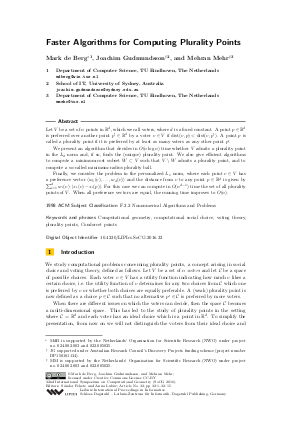Faster Algorithms for Computing Plurality Points
Authors Mark de Berg, Joachim Gudmundsson, Mehran Mehr
-
Part of:
Volume:
32nd International Symposium on Computational Geometry (SoCG 2016)
Part of: Series: Leibniz International Proceedings in Informatics (LIPIcs)
Part of: Conference: Symposium on Computational Geometry (SoCG) - License:
 Creative Commons Attribution 3.0 Unported license
Creative Commons Attribution 3.0 Unported license
- Publication Date: 2016-06-10
File

PDF
LIPIcs.SoCG.2016.32.pdf
- Filesize: 0.51 MB
- 15 pages
Document Identifiers
Subject Classification
Keywords
- computational geometry
- computational social choice
- voting theory
- plurality points
- Condorcet points
Metrics
- Access Statistics
-
Total Accesses (updated on a weekly basis)
0Document
0Metadata
Abstract
Let V be a set of n points in R^d, which we call voters, where d is a fixed constant. A point p in R^d is preferred over another point p' in R^d by a voter v in V if dist(v,p) < dist(v,p'). A point p is called a plurality point if it is preferred by at least as many voters as any other point p'.
We present an algorithm that decides in O(n log n) time whether V admits a plurality point in the L_2 norm and, if so, finds the (unique) plurality point. We also give efficient algorithms to compute the smallest subset W of V such that V - W admits a plurality point, and to compute a so-called minimum-radius plurality ball.
Finally, we consider the problem in the personalized L_1 norm, where each point v in V has a preference vector <w_1(v), ...,w_d(v)> and the distance from v to any point p in R^d is given by sum_{i=1}^d w_i(v) cdot |x_i(v)-x_i(p)|. For this case we can compute in O(n^(d-1)) time the set of all plurality points of V. When all preference vectors are equal, the running time improves to O(n).
Cite As Get BibTex
Mark de Berg, Joachim Gudmundsson, and Mehran Mehr. Faster Algorithms for Computing Plurality Points. In 32nd International Symposium on Computational Geometry (SoCG 2016). Leibniz International Proceedings in Informatics (LIPIcs), Volume 51, pp. 32:1-32:15, Schloss Dagstuhl – Leibniz-Zentrum für Informatik (2016)
https://doi.org/10.4230/LIPIcs.SoCG.2016.32
BibTex
@InProceedings{deberg_et_al:LIPIcs.SoCG.2016.32,
author = {de Berg, Mark and Gudmundsson, Joachim and Mehr, Mehran},
title = {{Faster Algorithms for Computing Plurality Points}},
booktitle = {32nd International Symposium on Computational Geometry (SoCG 2016)},
pages = {32:1--32:15},
series = {Leibniz International Proceedings in Informatics (LIPIcs)},
ISBN = {978-3-95977-009-5},
ISSN = {1868-8969},
year = {2016},
volume = {51},
editor = {Fekete, S\'{a}ndor and Lubiw, Anna},
publisher = {Schloss Dagstuhl -- Leibniz-Zentrum f{\"u}r Informatik},
address = {Dagstuhl, Germany},
URL = {https://drops.dagstuhl.de/entities/document/10.4230/LIPIcs.SoCG.2016.32},
URN = {urn:nbn:de:0030-drops-59248},
doi = {10.4230/LIPIcs.SoCG.2016.32},
annote = {Keywords: computational geometry, computational social choice, voting theory, plurality points, Condorcet points}
}
Author Details
References
-
H. K. Ahn, S. W. Cheng, O. Cheong, M. Golin, and R. van Oostrum. Competitive facility location: the Voronoi game. Theor. Comput. Sci., 310(1-3):457-467, 2004.

-
T. Chan. An optimal randomized algorithm for maximum tukey depth. In Proc. 15th ACM-SIAM Symp. Discr. Alg. (SODA), pages 430-436, 2004.

-
B. Chazelle. On the convex layers of a planar set. IEEE Trans. Inf. Theory, 31(4):509-517, 1985.

-
O. Cheong, S. Har-Peled, N. Linial, and J. Matousek. The one-round voronoi game. Discr. Comput. Geom., 31(1):125-138, 2004.

-
H. Edelsbrunner, J. O’Rourke, and R. Seidel. Constructing arrangements of lines and hyperplanes with applications. SIAM J. Comput., 15(2):341-363, 1986.

-
H. A. Eiselt and G. Laporte. Sequential location problems. Europ. J. Op. Res., 96(2):217-231, 1997.

-
J. Erickson. New lower bounds for convex hull problems in odd dimensions. SIAM J. Comput., 28(4):1198-1214, 1999.

-
A. Gajentaan and M. H. Overmars. On a class of o(n²) problems in computational geometry. Comput. Geom. Theory Appl., 5(3):165-185, 1995.

-
T. Gallai. Solution to problem number 4065. The American Mathematical Monthly, 51(3):169-171, 1944.

-
P. Hansen and J. F. Thisse. Outcomes of voting and planning: Condorcet, weber and rawls locations. Journal of Public Economics, 16(1):1-15, 1981.

-
P. Hansen, J. F. Thisse, and R. E. Wendell. Equivalence of solutions to network location problems. Mathematics of Operations Research, 11(4):672-678, 1986.

-
S. Jadhav, A. Mukhopadhyay, and B. Bhattacharya. An optimal algorithm for the intersection radius of a set of convex polygons. J. Alg., 20(2):244-267, 1996.

-
D. Kress and E. Pesch. Sequential competitive location on networks. Europ. J. Op. Res., 217(3):483-499, 2012.

-
W. Y. Lin, Y. W. Wu, H. L. Wang, and K. M. Chao. Forming plurality at minimum cost. In Proc. 9th Int. Workshop Alg. Comput. (WALCOM), LNCS 8973, pages 77-88, 2015.

-
R. D. McKelvey and R. E. .Wendell. Voting equilibria in multidimensional choice spaces. Math. Op. Res., 1(2):144-158, 1976.

-
J. W. Tukey. Mathematics and the picturing of data. In In Proc. Int. Cong. Mathematicians, volume 2, pages 523-531, 1975.

-
R. E. Wendell and R. D. McKelvey. New perspectives in competitive location theory. Europ. J. Op. Res., 6(2):174-182, 1981.

-
R. E. Wendell and S. J. Thorson. Some generalizations of social decisions under majority rule. Econometrica, 42(5):893-912, 1974.

-
Y. W. Wu, W. Y. Lin, H. L. Wang, and K. M. Chao. Computing plurality points and condorcet points in euclidean space. In Proc. 24th Int. Symp. Alg. Comput. (ISAAC), LNCS 8283, pages 688-698, 2013.

